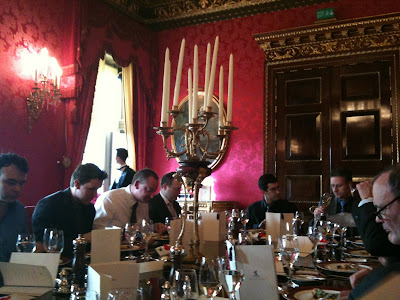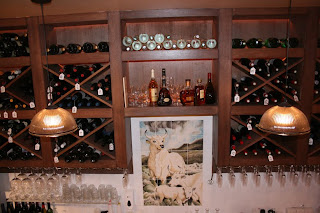 There are certain rites of passage in the life of a gastronome, and lunch at The Ritz is one of them. When a Ritz-shaped invitation landed on my desk the other week, I almost fell off my chair with excitement. Writing for a drinks magazine, I'm never short of enticing invitations, but there's something special about The Ritz. It still stands for something.
There are certain rites of passage in the life of a gastronome, and lunch at The Ritz is one of them. When a Ritz-shaped invitation landed on my desk the other week, I almost fell off my chair with excitement. Writing for a drinks magazine, I'm never short of enticing invitations, but there's something special about The Ritz. It still stands for something.
And so it was, that I left the office last week and headed for Green Park under a cornflower blue sky with a spring in my step. The lunch was celebrating the launch of Champagne Mumm Cuvée R. Lalou 1999. A chilled glass of Mumm NV awaited me on arrival, along with a besuited swarm of thirsty wine journalists. There was palapable excitement in the room in anticipation of the feast. I'd bumped into a Mumm rep at the recent Bibendum EC1 tasting, and, having already tasted through the menu, he informed me that black truffles made an appearance in almost every dish. My mouth had been watering for a week.
After a brief introductory speech by winemaker Didier Mariotti, we were soon ushered from the floral drawing room, through a pair of giant, gold-knockered doors into the Rubens red William Kent room complete with soaringly high ceilings, gothic candelabra, swagging that would make Laurence Llewelyn Bowen weep with pride, and quirky paintings of long limbed birds.
I was sat next to Sotheby's head of wine Serena Sutcliffe MW, resplendent in turquoise. She told me of her pre-Sotheby's days working as an interpreter in Paris, and went on to mention the recent Picasso sale at Sotheby's, where a portrait of Picasso's 17-year-old blonde mistress Marie-Thérèse Walter went for £25m. "Picasso walked up to her in the street and said 'we're going to do amazing things together'", Sutcliffe tells me, her blue eyes bright.
 After a verbal tour of the tasting menu from unsung head chef John Williams, lunch soon begins in earnest. As an experiment, we were to try six examples of the Cuvée R. Lalou, served at six different temperatures, two degrees apart from 6-16ºC, to explore how temperature effects the character of Champagne. The warmer the Champagne, the more dominant the Pinot Noir becomes in the blend.
After a verbal tour of the tasting menu from unsung head chef John Williams, lunch soon begins in earnest. As an experiment, we were to try six examples of the Cuvée R. Lalou, served at six different temperatures, two degrees apart from 6-16ºC, to explore how temperature effects the character of Champagne. The warmer the Champagne, the more dominant the Pinot Noir becomes in the blend.
The seven course meal begins in a spectacular fashion with a simple salad of Périgord truffles, king oyster mushrooms and Pecorino. The tangy cheese, papery mushrooms, heady truffle and citrusy salad make for a wonderful flavour combination. Both light and indulgent, intoxicating and refreshing – an oxymoron of a dish. Next up is carpaccio of smoked eel (pictured above), which looked like a play mat and tasted equally ludic, the eel perfectly complimented by the smokey slithers of pancetta and cooling beetroot cubes – inspired cooking.
 During an inter course of bresse chicken Champenoise, I seize the opportunity to ask Serena which she considers to be the best wines she's ever tasted, having undoubtedly had access to the best wines in the world. She takes a moment to reflect, then replies: "Domaine de la Romanée Conti 1921 and Cheval Blanc 1921". I linger over her liquid memories, knowing these two wines will always remain mythical to me. A confit of Brixham turbot follows, served with oxtail in a hazelnut butter. The hazelnut was woefully absent from the butter, and the oxtail savagely stole the turbot's thunder with its feral, meaty flavour.
During an inter course of bresse chicken Champenoise, I seize the opportunity to ask Serena which she considers to be the best wines she's ever tasted, having undoubtedly had access to the best wines in the world. She takes a moment to reflect, then replies: "Domaine de la Romanée Conti 1921 and Cheval Blanc 1921". I linger over her liquid memories, knowing these two wines will always remain mythical to me. A confit of Brixham turbot follows, served with oxtail in a hazelnut butter. The hazelnut was woefully absent from the butter, and the oxtail savagely stole the turbot's thunder with its feral, meaty flavour.
Stepping up the flavour a notch further, the turbot is succeeded by Anjou pigeon stuffed with foie gras in a black truffle sauce. I suddenly feel like one of Henry VIII's harem at a Tudor banquet – all we need is a harpsichord and silver goblets filled with mead. Rich and hedonistic, it was wonderfully indulgent, but my mind kept wondering back to the enchanting opening duo of dishes. But what of the wine? I wasn't able to detect vast amounts of flavour nuance from the differing temperatures, but the Cuvée impressed. It showed structure, power and elegance, with a toasty approach, and a smooth, nutty finish.

The surprise of the day came in the form of an egg cup filled with liquid Beaufort cheese, served with a trio of Marmite-laced soldiers. The cheese was soft, warm, and comforting, and once the soldiers had marched down my oesophagus, I tilted my head back and took it like a shot. I rather like the idea of cheese shots – we should drink food and eat drinks more. There's something rather quaint about a Marmite Croque Monsiuer – the former so quintessentially British, and the latter so unmistakably French. It represents a coming together of French and English breakfasts: diplomacy on a plate.
Before leaving the pleasure dome of The Ritz behind, I'm treated to a Mille Feuille of caramelised pink lady apples with Champagne ginger sorbet, artfully presented alongside a swoosh of caramel. The invigorating ginger sorbet had a biscuit halo, while the delightfully named pink lady apples were small and perfectly round, with a sweet, toffee apple flavour that went wonderfully well with the Mumm demi-sec. After a quick mint tea and miniature macaroon, I'm ushered out of the William Kent room, and back out onto the busy London streets. Still light, it feels as if waking from a dream, but the name card in my pocket serves as proof that for one afternoon, I lunched like a prince.


 The meal begins with peasant bread and pleasantly salted butter, enjoyed with Balfour Brut Rosé 2006, which could confidently hold its own beside the best rosé Champagnes. To start, I opt for smoked eel. Its slick skin gleams like a painted nail, and the smokiness fills my lungs before I even cut into its swan white interior. Its bacon-like flavour is complimented by a scoop of horseradish cream, though I was hoping for more kick from it – the cream rendering it too mild. The eel marries well with the vinegary beetroot and mini mountain of cubed potato, and proves a good match for my buttery Plantagenet Chardonnay.
The meal begins with peasant bread and pleasantly salted butter, enjoyed with Balfour Brut Rosé 2006, which could confidently hold its own beside the best rosé Champagnes. To start, I opt for smoked eel. Its slick skin gleams like a painted nail, and the smokiness fills my lungs before I even cut into its swan white interior. Its bacon-like flavour is complimented by a scoop of horseradish cream, though I was hoping for more kick from it – the cream rendering it too mild. The eel marries well with the vinegary beetroot and mini mountain of cubed potato, and proves a good match for my buttery Plantagenet Chardonnay.
















